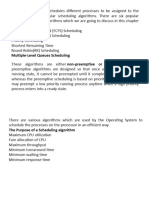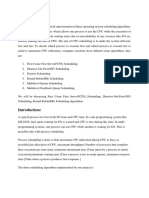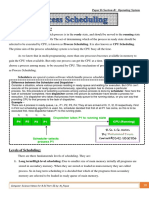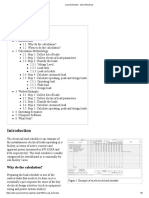Department of Computing: CLO4 (Design & Implement Various Pieces of OS Software)
Department of Computing: CLO4 (Design & Implement Various Pieces of OS Software)
Uploaded by
Danial AhmadCopyright:
Available Formats
Department of Computing: CLO4 (Design & Implement Various Pieces of OS Software)
Department of Computing: CLO4 (Design & Implement Various Pieces of OS Software)
Uploaded by
Danial AhmadOriginal Description:
Original Title
Copyright
Available Formats
Share this document
Did you find this document useful?
Is this content inappropriate?
Copyright:
Available Formats
Department of Computing: CLO4 (Design & Implement Various Pieces of OS Software)
Department of Computing: CLO4 (Design & Implement Various Pieces of OS Software)
Uploaded by
Danial AhmadCopyright:
Available Formats
Department of Computing
CS 330: Operating Systems
Lab 6: Process Scheduling
CLO4(Design & implement various pieces of OS software)
Time: 9.00 AM – 12:00 PM and 02:00 PM – 05:00 PM
Instructor: Dr. Pakeeza Akram
Lab 6: Process Scheduling
Introduction
The process scheduling is the activity of the process manager that handles the removal of the
running process from the CPU and the selection of another process on the basis of a particular
strategy.
Process scheduling is an essential part of a Multiprogramming operating systems. Such
operating systems allow more than one process to be loaded into the executable memory at a
time and the loaded process shares the CPU using time multiplexing.
Objectives
The purpose of this lab is to introduce the concept of process scheduling and let the study get
the hands on experience on writing process scheduling code for themselves
Tools/Software Requirement
Linux OS installed on laptops or systems.
Description
A Process Scheduler schedules different processes to be assigned to the CPU based on particular
scheduling algorithms. There are six popular process scheduling algorithms which we discussed in class
−
● First-Come, First-Served (FCFS) Scheduling
● Shortest-Job-Next (SJN) or Shortest Job First Scheduling
● Shortest Remaining Time
● Priority Scheduling
● Round Robin(RR) Scheduling
● Multiple-Level Queues Scheduling
These algorithms are either non-preemptive or preemptive. Non-preemptive algorithms are
designed so that once a process enters the running state, it cannot be preempted until it
completes its allotted time, whereas the preemptive scheduling is based on priority where a
scheduler may preempt a low priority running process anytime when a high priority process
enters into a ready state.
Priority Based Scheduling
● Priority scheduling is a non-preemptive algorithm and one of the most common
scheduling algorithms in batch systems.
● Each process is assigned a priority. Process with the highest priority is to be executed
first and so on.
● Processes with the same priority are executed on a first come first served basis.
● Priority can be decided based on memory requirements, time requirements or any other
resource requirement.
Round Robin Scheduling
● Round Robin is the preemptive process scheduling algorithm.
● Each process is provided a fix time to execute, it is called a quantum.
● Once a process is executed for a given time period, it is preempted and other process
executes for a given time period.
● Context switching is used to save the states of preempted processes.
Tasks
Following are the few tasks to perform.
Task 1:
Create a C code for priority scheduling. Working in the following manner. The program asks the
user to give the total number of jobs. User also provide the job ID, Burst time and the priority.
For each job compute the following: Calculate response time of each process and also compute
the turnaround time, Finish time and waiting time for each process. At the end, the program
should also compute the average waiting time as well. Also show and represent any kind of
Gantt Chart for the algorithm.
Task 2:
To implement Round Robin CPU scheduling algorithm. The program should ask for the list
of processes and their arrival time and burst time. It also ask the user for quantum time. Do
the round robin scheduling and provide the finish time, waiting time, turnaround time and at
the end also show the list of all processes in any form of Gantt Chart.
Deliverables:
C code with all instructions to execute the code.
You might also like
- Module 14Document17 pagesModule 14Zbor ZborNo ratings yet
- The Challenge of Social Innovation in Urban RevitalizationDocument273 pagesThe Challenge of Social Innovation in Urban Revitalizationsuraci2No ratings yet
- Osy MicroDocument12 pagesOsy Microatul gaikwadNo ratings yet
- Unit 9 SchedulingDocument14 pagesUnit 9 SchedulingCindy CortezNo ratings yet
- Operating SystemDocument15 pagesOperating System182TISHAN KOLEHNo ratings yet
- Exp3 1Document11 pagesExp3 1bangi arfatNo ratings yet
- CPU Scheduling Preemptive Non Preemptive SchedulingDocument8 pagesCPU Scheduling Preemptive Non Preemptive SchedulingParkhi AcchrejaNo ratings yet
- Module 3-OsDocument36 pagesModule 3-Oscreations400abNo ratings yet
- Process Management: By: Modaser SadatDocument10 pagesProcess Management: By: Modaser SadatModaser SadatNo ratings yet
- Multiple-Level Queues SchedulingDocument16 pagesMultiple-Level Queues Schedulingyogitapatilx12No ratings yet
- Unit-3 (CPU Scheduling & Deadlocks)Document128 pagesUnit-3 (CPU Scheduling & Deadlocks)SseieprNo ratings yet
- Scheduling AlgorithmsDocument12 pagesScheduling Algorithmssriniha1005No ratings yet
- COA Chapter 4Document10 pagesCOA Chapter 42018796.cse.coeNo ratings yet
- Lecture 4 - Process - CPU SchedulingDocument38 pagesLecture 4 - Process - CPU SchedulingtalentNo ratings yet
- Module 3 CPU Process SchedulingDocument4 pagesModule 3 CPU Process SchedulingMc John PobleteNo ratings yet
- 227 122 RTOS - Module 2Document97 pages227 122 RTOS - Module 2AlonaNo ratings yet
- Operating Systems Project Based LabDocument6 pagesOperating Systems Project Based LabBeverly NortonNo ratings yet
- Operating System NotesDocument68 pagesOperating System NotesPratyush GoelNo ratings yet
- Operating System Scheduling AlgorithmsDocument5 pagesOperating System Scheduling AlgorithmsVaibhav PearsonNo ratings yet
- Report On Os SchedulingDocument5 pagesReport On Os SchedulingWinner WinnerNo ratings yet
- Process SchedulingDocument10 pagesProcess SchedulingHabesha CryptoNo ratings yet
- Process ManagementDocument66 pagesProcess ManagementVanessa TabalanNo ratings yet
- Unit 04Document22 pagesUnit 04oooNo ratings yet
- Chapter 4 NotesDocument34 pagesChapter 4 NotesPARTH KILANJENo ratings yet
- OS 3 CPU IO SchedulingDocument30 pagesOS 3 CPU IO SchedulingRitesh KumarNo ratings yet
- CPU Scheduling in Operating SystemsDocument17 pagesCPU Scheduling in Operating Systemsezekiel nyamuNo ratings yet
- Gurpreet Singh RA1805 Roll No 17Document99 pagesGurpreet Singh RA1805 Roll No 17Gurpreet SinghNo ratings yet
- ProcessDocument19 pagesProcessshraddha wadnerkarNo ratings yet
- Unit 2 - Operating System - WWW - Rgpvnotes.in PDFDocument30 pagesUnit 2 - Operating System - WWW - Rgpvnotes.in PDFPrakrti MankarNo ratings yet
- 3 - Process Management Ver2Document34 pages3 - Process Management Ver2John Mark CuNo ratings yet
- CPU Scheduling in Operating SystemDocument13 pagesCPU Scheduling in Operating SystemdivyaNo ratings yet
- Simulation of Scheduling AlgorithmsDocument18 pagesSimulation of Scheduling Algorithmsashishpatel_99100% (1)
- An Optimized Round Robin Scheduling Algorithm For CPU Scheduling PDFDocument3 pagesAn Optimized Round Robin Scheduling Algorithm For CPU Scheduling PDFccalero78No ratings yet
- Process SchedullingDocument4 pagesProcess SchedullingzamakbNo ratings yet
- UNIT-II Notes (Operating Systm) OsDocument37 pagesUNIT-II Notes (Operating Systm) OsVaishnavi RaveNo ratings yet
- Process Schedduling-Synchronization and Deadlock Course MaterialDocument41 pagesProcess Schedduling-Synchronization and Deadlock Course MaterialShivani AppiNo ratings yet
- Lec 4 Process ManagmentDocument26 pagesLec 4 Process Managmentomare paulNo ratings yet
- Process SchedulingDocument5 pagesProcess SchedulingKnoel Gen GutierrezNo ratings yet
- Cpu SchedulingDocument26 pagesCpu SchedulingBobby chNo ratings yet
- Cpu Scheduling - NewDocument8 pagesCpu Scheduling - Newcikiyor281No ratings yet
- Operating System: CPU SchedulingDocument39 pagesOperating System: CPU SchedulingFaizan Ahmed100% (1)
- Process ManagementDocument25 pagesProcess ManagementLinda BrownNo ratings yet
- Scheduling: Ren-Song Ko National Chung Cheng UniversityDocument57 pagesScheduling: Ren-Song Ko National Chung Cheng UniversityjunaidNo ratings yet
- 2.1 Basics Concepts, Scheduling CriteriaDocument12 pages2.1 Basics Concepts, Scheduling CriteriaavishanaNo ratings yet
- CPU SchedualingDocument7 pagesCPU SchedualingTaimoor ZubairNo ratings yet
- OS Unit-3Document52 pagesOS Unit-3naudiyalabhinav59No ratings yet
- CPU Scheduling in Operating SystemsDocument3 pagesCPU Scheduling in Operating SystemsAbu SufianNo ratings yet
- Process SchedulingDocument83 pagesProcess SchedulingSai SanthoshNo ratings yet
- L6 CPU SchedulingDocument20 pagesL6 CPU Schedulingpuja1002.hrNo ratings yet
- Chapter 3 1Document34 pagesChapter 3 1Carl Irven Nykuluz MillanesNo ratings yet
- AKASH CHOWDHURY - OpppDocument5 pagesAKASH CHOWDHURY - Oppppriyanka.debnath.cse.2021No ratings yet
- Operating System Chapter 4Document7 pagesOperating System Chapter 4Hafsa SafdarNo ratings yet
- Operating System Chapter 3 SchedulingDocument10 pagesOperating System Chapter 3 SchedulingFakhr UddinNo ratings yet
- Cpu ShedulingDocument22 pagesCpu ShedulingRaviteja PapeneniNo ratings yet
- Multi Level CPU Scheduling: AbstractDocument5 pagesMulti Level CPU Scheduling: AbstractPawanPaagalNo ratings yet
- Unit IIIDocument39 pagesUnit IIIKHARDEKAR SUJALNo ratings yet
- Lecture4 SchedulingDocument97 pagesLecture4 SchedulingAryan katiyarNo ratings yet
- Operating System CPU Scheduling and Algorithms: Mrs A.S.KhandagaleDocument149 pagesOperating System CPU Scheduling and Algorithms: Mrs A.S.Khandagalemanasikotwal00No ratings yet
- Chapter 03 CPU Scheduling NewDocument40 pagesChapter 03 CPU Scheduling NewMickNo ratings yet
- Os Process Scheduling AlgorithmsDocument4 pagesOs Process Scheduling Algorithmsثقف نفسكNo ratings yet
- CPU SchedulingDocument10 pagesCPU SchedulingnageswararaosontineniNo ratings yet
- Department of Computing: Lab 12: React Native Login ApplicationDocument3 pagesDepartment of Computing: Lab 12: React Native Login ApplicationDanial AhmadNo ratings yet
- Lab 9 Cs 7Document4 pagesLab 9 Cs 7Danial AhmadNo ratings yet
- Lab 10 OsDocument3 pagesLab 10 OsDanial AhmadNo ratings yet
- Lab 12 OsDocument2 pagesLab 12 OsDanial AhmadNo ratings yet
- Department of Computing: CLO3 (Design & Implement Various Pieces of OS Software)Document5 pagesDepartment of Computing: CLO3 (Design & Implement Various Pieces of OS Software)Danial AhmadNo ratings yet
- Department of Computing: Instructor: Dr. Sidra Sultana Lab Engineer: Ms. Ayesha AsifDocument4 pagesDepartment of Computing: Instructor: Dr. Sidra Sultana Lab Engineer: Ms. Ayesha AsifDanial AhmadNo ratings yet
- Lecture # 19 - Reactnative Login Manager: by Dr. Sidra SultanaDocument37 pagesLecture # 19 - Reactnative Login Manager: by Dr. Sidra SultanaDanial AhmadNo ratings yet
- Lecture # 18 - React Native Navigations: by Dr. Sidra SultanaDocument53 pagesLecture # 18 - React Native Navigations: by Dr. Sidra SultanaDanial AhmadNo ratings yet
- Lecture # 16 - React Native Library To Validate Form FieldsDocument13 pagesLecture # 16 - React Native Library To Validate Form FieldsDanial AhmadNo ratings yet
- Lecture # 8 - Express - .JsDocument35 pagesLecture # 8 - Express - .JsDanial AhmadNo ratings yet
- Department of Computing: Lab 07: Express JSDocument5 pagesDepartment of Computing: Lab 07: Express JSDanial AhmadNo ratings yet
- Lecture # 17 - React Native Form Handling: by Dr. Sidra SultanaDocument21 pagesLecture # 17 - React Native Form Handling: by Dr. Sidra SultanaDanial AhmadNo ratings yet
- Department of Computing: Lab 5: Node - Js MysqlDocument4 pagesDepartment of Computing: Lab 5: Node - Js MysqlDanial AhmadNo ratings yet
- Lecture # 14 - ReactNativeDocument20 pagesLecture # 14 - ReactNativeDanial AhmadNo ratings yet
- Lecture # 7 - Node - .Js MongoDbDocument39 pagesLecture # 7 - Node - .Js MongoDbDanial AhmadNo ratings yet
- Lecture # 12 - Introduction To React JSDocument76 pagesLecture # 12 - Introduction To React JSDanial AhmadNo ratings yet
- Department of Computing: Lab 06: Node - Js MongodbDocument4 pagesDepartment of Computing: Lab 06: Node - Js MongodbDanial AhmadNo ratings yet
- Lecture # 13 - React - Part II: Advanced ProgrammingDocument49 pagesLecture # 13 - React - Part II: Advanced ProgrammingDanial AhmadNo ratings yet
- Lecture # 3 Introduction To JqueryDocument88 pagesLecture # 3 Introduction To JqueryDanial AhmadNo ratings yet
- Lecture # 2 - Introduction To JavascriptDocument38 pagesLecture # 2 - Introduction To JavascriptDanial AhmadNo ratings yet
- Lecture # 6 - Node - .Js MySQLDocument45 pagesLecture # 6 - Node - .Js MySQLDanial AhmadNo ratings yet
- Lecture # 5 Introduction To Node - Js (Part II) : by Dr. Sidra SultanaDocument29 pagesLecture # 5 Introduction To Node - Js (Part II) : by Dr. Sidra SultanaDanial AhmadNo ratings yet
- CS-213 Advance Programming: Dr. Sidra SultanaDocument12 pagesCS-213 Advance Programming: Dr. Sidra SultanaDanial AhmadNo ratings yet
- SC813MDocument54 pagesSC813MAndy KongNo ratings yet
- 03 Engine Bottom EndDocument31 pages03 Engine Bottom EndRohit Raj100% (1)
- Cyber Security ToolsDocument13 pagesCyber Security ToolsSamir AslanovNo ratings yet
- Power System Analysis Lab ManualDocument71 pagesPower System Analysis Lab ManualAnkit Raj SinghNo ratings yet
- Fetching Data Directly From ECC System in BEX Query Using RRIDocument11 pagesFetching Data Directly From ECC System in BEX Query Using RRIwaiting4addNo ratings yet
- OrioninstallerguideDocument35 pagesOrioninstallerguideHassan AyoubNo ratings yet
- Ansi C57.12&iec 76 PDFDocument8 pagesAnsi C57.12&iec 76 PDFfreddy vargas100% (2)
- 5-14 NewDocument9 pages5-14 NewVASUDEVAN N (RC2113003011006)No ratings yet
- Icpna Cusco HomeworkDocument4 pagesIcpna Cusco Homeworkzoldoiwlf100% (1)
- Psim Interface Opal RTDocument33 pagesPsim Interface Opal RTtvs_krishnavarmaNo ratings yet
- FPGADocument33 pagesFPGAmuhammad100% (5)
- Product Specifications Product SpecificationsDocument4 pagesProduct Specifications Product SpecificationsPT Bumi Raya PerkasaNo ratings yet
- X7Electrical Instrument Telecommmucation Test PlanDocument15 pagesX7Electrical Instrument Telecommmucation Test PlanNoor A QasimNo ratings yet
- NetPro Template SentDocument186 pagesNetPro Template SentVăn ThuậtNo ratings yet
- SX80 Process Controller: DescriptionDocument3 pagesSX80 Process Controller: DescriptionMário CoutoNo ratings yet
- 02 - Efficient Switching, Protection, Control, and Monitoring of Motors With SIRIUS PortfolioDocument35 pages02 - Efficient Switching, Protection, Control, and Monitoring of Motors With SIRIUS PortfolioMuhammad SyaifulhaqNo ratings yet
- Automated Selection of Materialized Views and Indexes For SQL DatabasesDocument10 pagesAutomated Selection of Materialized Views and Indexes For SQL DatabaseswilhelmjungNo ratings yet
- MS For The Access Control System Installation and TerminationDocument21 pagesMS For The Access Control System Installation and Terminationwaaji snapNo ratings yet
- User Manual DropMindDocument94 pagesUser Manual DropMindgduicuNo ratings yet
- Load ScheduleDocument8 pagesLoad SchedulemerebookNo ratings yet
- En 1998 12Document100 pagesEn 1998 12Vio Chi100% (4)
- Giz TVET Concept Note Open For Further DiscussionDocument6 pagesGiz TVET Concept Note Open For Further DiscussionHayat Abdela MohammedNo ratings yet
- Motorola GM-300 Information PageDocument17 pagesMotorola GM-300 Information PagesaadfarazkhanNo ratings yet
- ABAP Tutorial (Verdy)Document171 pagesABAP Tutorial (Verdy)vn_wdjjNo ratings yet
- Fortigate Exam ResultDocument5 pagesFortigate Exam Resultantony_cmNo ratings yet
- MATLAB For Data Processing and Visualization Quick ReferenceDocument11 pagesMATLAB For Data Processing and Visualization Quick ReferenceEdrian PentadoNo ratings yet
- 42B04 Service ManualDocument51 pages42B04 Service Manualequus43No ratings yet
- 1Z0 1057 DemoDocument8 pages1Z0 1057 DemoMohamed ElnaggarNo ratings yet
















































































































